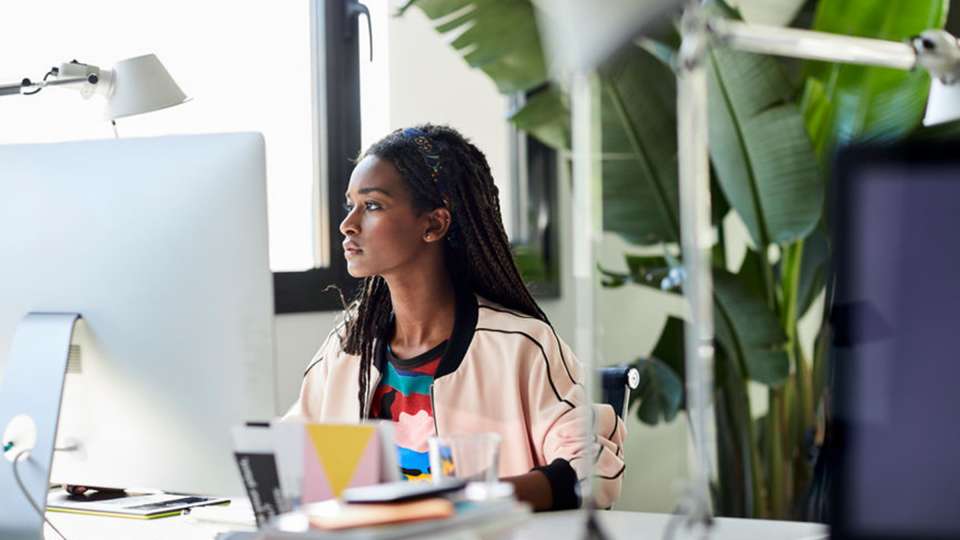
You wake up in the morning, commute in, stare at a computer screen for hours on end, commute home, make dinner, watch some Netflix, go to bed.
This is a standard day for many of us who work in offices or at desks. So what’s wrong with this picture?
There’s a lot of sitting. And staring. Neither of which is good for your health.
Sitting disease is real
We know that sitting all day at work, in the car or on the bus, and for much of the evening at home isn’t healthy. We’ve known at least since the late '90s, when research linked physical inactivity and poor health.
So, why do we still sit all the time?
Sitting is built into American culture. Now that so many of us are working behind a computer rather than doing more hands-on work that involves movement, sitting has become a hard habit to break.
Things like where someone lives, how close they live to parks, neighborhood walkability, availability of public transportation and many other factors that are built into our lives can influence how often (or not) we are active during the day.
“One of the most striking changes to workspaces over the last century is we’ve shifted from standing to sitting. It obviously has a substantial impact on overall health. Even outside of work, more than 60 percent of our waking lives are spent sitting,” says Christopher McMullen, M.D., a rehabilitation medicine specialist who practices at the sports medicine clinics at Husky Stadium and Harborview Medical Center.
There’s even a trendy term for our newfound sedentary lifestyle: sitting disease. Sitting disease is associated with higher mortality rates for many serious health conditions, from heart disease to diabetes to cancer.
Eye strain is also real
You know that dry, tired feeling your eyes get when you’ve been staring at screens all day? There’s a name for that feeling: eye strain. Though it’s definitely uncomfortable, it’s probably not going to harm your vision.
“Eye strain usually isn't serious and goes away once you rest your eyes,” says Jay Neitz, Ph.D., a professor in the ophthalmology department at the University of Washington School of Medicine.
More concerning, he says, is the possibility that too much screen time can cause permanent vision damage. Nearsightedness, sometimes called myopia, is increasing in the U.S. population according to some research. Children and young people under age 25 are particularly at risk.
Myopia also puts people at greater risk for developing glaucoma, a group of eye diseases that cause blindness.
“A high incidence of glaucoma has been observed in heavy computer users, and those who were nearsighted seemed to have a higher risk,” Neitz says.
All of this about sitting disease and eye problems can sound scary, but there are simple ways you can decrease your sitting and staring time and increase your active time. (Yes, even if you’re always busy at work.)
Change your computer setup
If you’re one of the many who sit all day at work, you may not even realize how much your body is contorting to make the position comfortable.
“It’s a problem if your body has to adapt to your workspace, rather than your workspace adapting to your body,” McMullen says.
This includes everything from the height and distance of your monitor, your ability to stand if you want to, the positioning of your mouse and keyboard and the type of mouse and keyboard you use.
Finding the most comfortable setup for you will probably involve some trial and error, McMullen says, depending on your personal needs and how flexible your workspace is.
A desk that adjusts for both sitting and standing positions is optimal. If that’s not an option, see if you can get something to set on your desk to raise your monitor up.
It doesn’t have to be fancy: McMullen and his colleagues prop up a shared computer with reams of paper, taking some away for people who are shorter and adding more reams for people who are taller.
Your shoulders should be relaxed at your side, your elbows flexed around 90 degrees while you type. Your feet should be firmly on the ground.
To reduce eye strain, you can try sitting or standing farther from your monitor, taking short breaks to look off into the distance (an approach called the 20-20-20 rule), and making sure there isn’t too much contrast between how bright your screen is and how bright your surrounding space is.
There is little scientific evidence that these methods work, however, Neitz says. If you want to try them, it probably isn’t going to do any harm, but don’t count on getting relief.
If you have a disability or chronic condition that is affected by your work setup, you have every right to reach out to your supervisor and request something different that better suits you.
“It’s on the employer and workplace to make something that’s workable for you,” McMullen says.
Sit right
If you must sit, there are ways to minimize its negative effects on your body. Hunching over a laptop, for example, definitely doesn’t make the cut.
“Over time, there’s some comfort that builds in the slouched, shoulders forward, neck extended position, but it’s not healthy for our shoulders, arms, spine and everything else,” McMullen says.
Instead, try rolling your shoulders back, sticking your chest out, pulling your chin back, and sitting forward on your backside instead of putting all your weight on your tailbone. McMullen describes this way of sitting as “when your grandma tells you to sit up at the dinner table.”
Use that as a reminder to correct your posture the next time you catch yourself slouching, even if you’re standing. If you want more guidance, there are posture-training apps that can provide detail, McMullen says.
Make standing the norm
If you have a desk that allows for both sitting and standing, try changing your perspective: Instead of sitting most of the day and taking standing breaks, try standing most of the day and taking sitting breaks.
If you stand more, you might notice your posture gets better on its own. “When standing, we tend to fall into a better posture because it’s just the nature of being upright,” McMullen says.
Even if you can’t stand for eight hours straight (who can?!) that’s OK. The ultimate goal is just to break the cycle of sitting all day.
It’s important to note, however, that standing all day doesn’t make up for a largely sedentary lifestyle, McMullen says. Standing at your desk can reduce neck and shoulder pain triggered by slouching when you sit. Standing can also help correct posture. But standing isn’t exercise, so even if you stand at work you should still try to find time in the day to be active.
Take a break
While things like decreasing sitting and adjusting your desk can be helpful, it’s also important to make time during the day to be active, even just for a few minutes.
Taking a break is a great way to do this. Get away from your desk. Take a walk around the block, make a coffee run, go chat with a coworker, meditate for a few minutes in an empty meeting room, stretch or do a few reps of walking up and down stairs.
If you’re one of those people who doesn’t take breaks because you’re too busy, try challenging that mindset and recognizing that even five minutes away from your desk will actually help you be more productive.
“The fear is people seeing this as interrupting your productivity, but overall it can make you more efficient and a happier person,” McMullen says.
Limit screen time
If possible, the best way to protect your eyes is by not staring at a screen as much. This isn’t exactly helpful advice for people whose jobs require them to be on a computer all day, though.
If this mirrors your situation, you can try to be more mindful and make yourself blink more when staring at a screen. And if there’s a way to limit your screen time at home, like using your phone less, that could help your eyes feel less tired.
Ultimately, more research is needed to better understand how screens impact our eyes long-term so effective solutions can be developed, Neitz says.
“In the Department of Ophthalmology at the UW we are working on these problems. One hope is to ultimately develop computer screens that are less damaging to our vision,” he says.
Consider your mental health
McMullen stresses that, while making ergonomic adjustments to your workspace can help prevent sitting disease and make someone physically feel more comfortable during the day, taking these steps is also important for mental health.
“The idea of not being confined to one area is important, so take those breaks. Also, bring in pieces of your outside world, like pictures of family or a vacation, to help you escape a little during the day,” McMullen says.

 Healthy ideas for your inbox
Healthy ideas for your inbox





